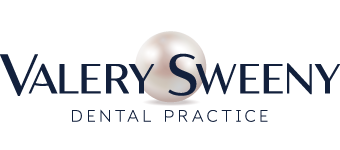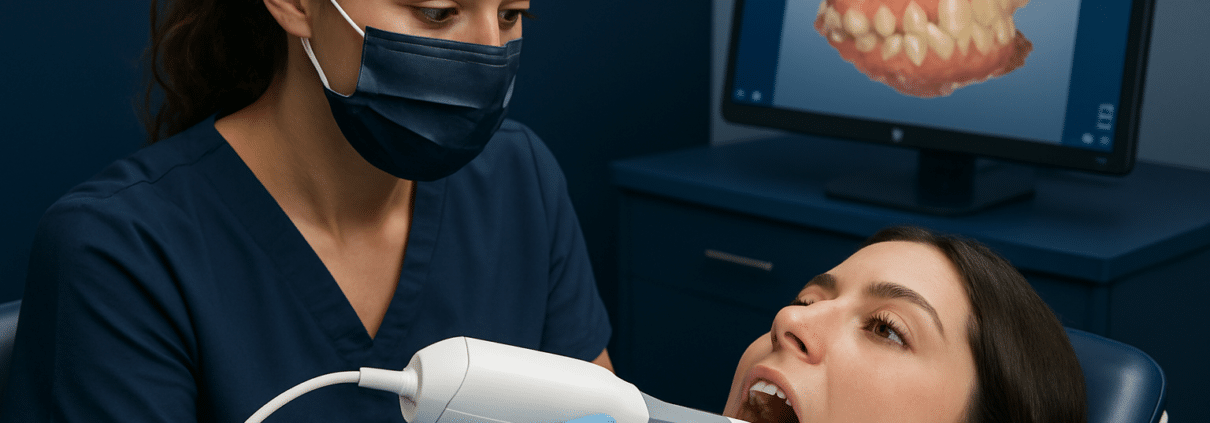Gone are the days of bite trays, goopy impressions, and 15 minutes of jaw clenching while your dentist makes a mold of your teeth. Welcome to the era of intraoral scanners—the dental technology that’s replacing mess with precision, speed, and comfort.
The rise in intraoral scanner uses is one of the biggest shifts in modern dentistry. Whether you’re getting Invisalign, crowns, or just a routine exam, this tiny handheld device is rewriting the rules of your dental visit. Here’s how.
TLDR – Quick Guide
- Intraoral scanners are replacing traditional impressions with digital scans—faster, cleaner, and more accurate.
- They’re used in everything from cosmetic planning to oral cancer detection.
- Patients benefit from shorter appointments and improved outcomes.
- Dental clinics like Valery Sweeny, DDS are using this tech to enhance both diagnostics and patient experience.
Detailed Breakdown: Top 5 Intraoral Scanner Uses
1. No More Gag-Inducing Impressions
Let’s be honest: traditional dental impressions are awful. Intraoral scanners use high-resolution cameras to create a 3D digital model of your teeth—no trays, no mess, no gagging.
- Use Case: Crowns, bridges, implants, and retainers
- Benefit: Increased comfort and faster turnaround time
- Game-Changer Factor: High—especially for patients with strong gag reflexes or dental anxiety
2. Faster and More Accurate Invisalign Planning
Intraoral scanners are now the industry standard for clear aligner treatment. The accuracy of digital scans leads to better-fitting trays and fewer mid-treatment adjustments.
- Use Case: Invisalign and other orthodontic treatment
- Benefit: Streamlined planning and fewer refinements
- Game-Changer Factor: Huge—especially for teens and busy professionals
3. Real-Time Patient Education
Many scanners provide a visual on-screen 3D rendering of your mouth, which dentists can rotate and zoom into. This allows for crystal-clear explanations of issues like cavities, wear, and gum recession.
- Use Case: Diagnostic exams and treatment plans
- Benefit: Patients actually understand their oral health
- Game-Changer Factor: Moderate—but excellent for trust and transparency
4. Improved Crown and Veneer Fittings
Thanks to precise scanning, restorations like crowns, inlays, onlays, and veneers fit better, look more natural, and require fewer adjustments.
- Use Case: Cosmetic and restorative dentistry
- Benefit: Fewer follow-up appointments and better long-term results
- Game-Changer Factor: High—precision equals durability
5. Early Detection of Oral Health Issues
Advanced intraoral scanners can capture fine details that help detect decay, wear, or lesions that might go unnoticed in a traditional visual exam.
- Use Case: Preventive care and monitoring
- Benefit: Early intervention = less invasive treatment later
- Game-Changer Factor: Essential—especially for high-risk patients
Why Dentists Are Making the Switch
Dental offices across Los Angeles, including Valery Sweeny, DDS, are embracing intraoral scanning technology because it’s better for everyone:
- Clinicians: More accurate records and streamlined workflows
- Labs: Faster turnaround and better-fitting appliances
- Patients: Shorter appointments, clearer communication, and no post-impression trauma
It’s not just a shiny gadget—it’s a serious upgrade in patient care.
Key Takeaways
- Intraoral scanner uses are transforming modern dentistry from diagnostics to treatment planning.
- They eliminate discomfort and inaccuracy from traditional impressions.
- Scanners streamline orthodontic treatments like Invisalign, and improve the fit of restorations.
- Patients benefit from real-time visuals and early issue detection.
- Forward-thinking practices in LA, like Valery Sweeny, DDS, are leading the charge in implementing this tech for a better dental experience.
FAQs
Are intraoral scans as accurate as traditional impressions?
They’re actually more accurate. Digital scanning minimizes human error and captures precise 3D data.
Does the scan hurt or cause discomfort?
Not at all. The scanner is a small wand that glides comfortably around your mouth—no trays or putty.
How long does an intraoral scan take?
Most full-mouth scans are completed in under five minutes.
Can intraoral scanners detect cavities?
They can reveal early signs of decay, especially when paired with diagnostic tools like fluorescence or transillumination.
Is this technology available at all dental offices?
Not yet, but more practices are adopting it. Clinics like Valery Sweeny, DDS already use intraoral scanners for a wide range of services.
Dental pain doesn’t wait until payday. And unfortunately, neither do most dental bills. If you’ve ever Googled “dental office near me accepting payment plans,” you’re not alone. Millions of Americans delay treatment not because they want to—but because they can’t afford it upfront.
But here’s the good news: finding a quality dental office that offers flexible payments is totally doable. You just need to know what to look for—and what to avoid. This guide walks you through how to choose a dental provider who gets it: that great care shouldn’t depend on having cash on hand.
TLDR – Quick Guide
- Many dental offices now offer payment plans to make care more accessible.
- Not all plans are created equal—some are in-house, others through third-party lenders.
- Look for clear pricing, transparent terms, and practices that work with your budget, not against it.
- Trusted providers like Valery Sweeny, DDS in Los Angeles combine high-quality care with flexible payment options.
Implementation Tactics: How to Find the Right Dental Office Near You Accepting Payment Plans
1. Know the Types of Payment Plans Available
There are typically two routes:
- In-House Payment Plans: Offered directly by the dental office. These usually come with 0% interest and personalized terms but may require credit checks or down payments.
- Third-Party Financing: Services like CareCredit, LendingClub, or Sunbit partner with the practice to offer medical credit lines. These can help break big bills into manageable monthly chunks.
Ask which option the office provides—and get the terms in writing.
2. Use the Right Search Phrases
Searching “dentist near me” won’t cut it. Be specific:
- “Dental office near me accepting payment plans”
- “Affordable dental care with financing in [your city]”
- “Dentists that accept CareCredit near me”
Pro tip: Include your ZIP code for hyper-local results.
3. Read the Fine Print
Before you commit:
- What’s the interest rate? Some third-party plans have 0% intro offers that balloon after 6–12 months.
- Is there a credit check?
- Are there penalties for late payments?
- Can you combine insurance with a payment plan?
If the office dodges these questions, walk away.
4. Check Online Reviews for Billing Transparency
Payment flexibility is only helpful if the billing process is clear and honest. Look for reviews that mention:
- Ease of setting up a plan
- No hidden fees or surprise charges
- Friendly, accommodating billing staff
Sites like Google, Yelp, and Zocdoc can help you filter out the flakes.
5. Book a Consultation First
Still unsure? Many reputable offices offer free consultations or low-cost exams for new patients. This gives you a chance to:
- Ask about pricing and plans in person
- Evaluate the vibe of the office
- See if they pressure you into unnecessary procedures
Good dental care shouldn’t feel like a car dealership pitch.
Spotlight: Affordable, Flexible Dental Care in Los Angeles
At Valery Sweeny, DDS, the team understands that affordability matters. This Silver Lake-based practice offers:
- Transparent treatment plans
- Payment flexibility tailored to patient needs
- Support for CareCredit and other financing platforms
- A judgment-free environment where your budget is respected
This is the kind of care LA deserves: high quality, fairly priced, and human-first.
Key Takeaways
- A dental office near you accepting payment plans can make all the difference between delayed care and immediate relief.
- Not all payment plans are created equal. Understand the terms, check the reviews, and don’t be afraid to ask tough questions.
- Look for in-house flexibility or partnerships with trusted financing platforms like CareCredit.
- The best dental providers combine transparency, compassion, and payment support—not pressure or confusion.
- In LA, practices like Valery Sweeny, DDS are leading the charge in affordable, accessible oral health.
FAQs
Are dental payment plans only for expensive procedures?
Not at all. Even cleanings and fillings can be covered by payment plans depending on the office.
Do all dentists offer payment plans?
No. It varies by provider. Always call ahead or check their website before booking.
Can I get a payment plan with bad credit?
Some offices offer no-credit-check plans or flexible in-house financing. Ask what your options are.
Are there interest-free dental payment plans?
Yes. Many practices offer 0% interest if the balance is paid within a certain timeframe, typically 6–12 months.
Can I use dental insurance and still get a payment plan?
Yes. Insurance usually covers part of the cost, and the remainder can often be split into manageable payments.
In the image-obsessed city of Los Angeles, a bright, white smile isn’t just a confidence booster—it’s practically currency. But not all whitening treatments are created equal. From $10 drugstore strips to $600 in-office sessions, the city is teeming with options, promises, and plenty of letdowns.
So how do you cut through the bleachy noise and find tooth whitening services in Los Angeles that actually work? This guide spills the (whitening-safe) tea on what’s effective, what’s a gimmick, and how to choose the right treatment for your smile and budget.
TLDR – Quick Guide
- Los Angeles offers a wide range of whitening options—from boutique dental spas to CVS aisles.
- In-office treatments like Zoom! and Opalescence produce faster, more noticeable results.
- DIY and over-the-counter products offer convenience but deliver inconsistent outcomes.
- Long-term success depends on maintenance and professional guidance.
- Local practices like Valery Sweeny, DDS offer safe, tailored whitening solutions with expert supervision.
Implementation Tactics: What Works vs. What Doesn’t
In-Office Professional Whitening: What Works
Zoom! Whitening
One of LA’s most popular choices. It uses a high-powered LED light in combination with hydrogen peroxide gel to visibly brighten teeth by several shades in just one visit.
- Effectiveness: High
- Cost: $300–$600 per session
- Pros: Instant results, safe, dentist-supervised
- Cons: Temporary sensitivity
Opalescence Boost
No light needed—just a powerful chemically activated gel. Dentists love it for its consistency and customization.
- Effectiveness: High
- Cost: $250–$500
- Pros: Controlled application, less sensitivity
- Cons: May require multiple visits for deep stains
Custom Take-Home Trays (From Your Dentist)
Dentists create molds of your teeth and provide clinical-grade whitening gel for at-home use over 1–2 weeks.
- Effectiveness: Moderate to High
- Cost: $200–$400
- Pros: Fits perfectly, less risk of gum irritation
- Cons: Slower results than in-office treatments
Over-the-Counter Products: What Sometimes Works
Whitening Strips
Think Crest Whitestrips. They’re everywhere—and they do something, just not a dramatic something.
- Effectiveness: Low to Moderate
- Cost: $20–$60
- Pros: Accessible, easy to use
- Cons: Uneven results, sensitivity, not great for crooked teeth
Whitening Toothpaste & Charcoal Powders
Mild abrasives can scrub away surface stains, but they don’t actually whiten teeth.
- Effectiveness: Low
- Cost: $5–$15
- Pros: Good for maintenance
- Cons: Limited impact, risk of enamel wear with excessive use
Instagram Trends to Avoid: What Doesn’t Work
LED Whitening Kits from Influencers
They look cool, they light up, and they promise magic—but the results are often minimal unless paired with potent gel (which many kits lack).
Oil Pulling and DIY Baking Soda Mixes
Oil pulling with coconut oil is great for oral hygiene—but not whitening. And DIY baking soda mixes? Risky business for your enamel.
What to Look for in a Tooth Whitening Service in LA
- Reputation & Reviews: Yelp, Google, and Zocdoc will tell you who’s whitening smiles vs. burning gums.
- Transparency on Ingredients: Any pro clinic should disclose their gel’s concentration and safety measures.
- Aftercare Support: Whitening isn’t one-and-done—your provider should advise on post-treatment care.
- Customized Approach: Avoid “one-size-fits-all” deals. Your teeth (and stains) are unique.
Where to Get Trusted Whitening in Los Angeles
If you want reliable tooth whitening services in Los Angeles, look no further than Silver Lake’s Valery Sweeny, DDS. With decades of cosmetic dental experience and a clear focus on patient safety, Dr. Sweeny provides personalized whitening options that actually live up to the hype—no gimmicks, no unnecessary upsells.
Key Takeaways
- Professional in-office treatments are your best bet for fast, dramatic, and safe whitening results.
- DIY kits and strips work in a pinch, but results vary and sensitivity can be a problem.
- Avoid fads like charcoal powders and random LED gadgets with no clinical backing.
- Choose a whitening service in LA based on trust, not just trends or pricing.
- Dentists like Valery Sweeny, DDS offer science-backed, custom solutions designed for real results.
FAQs
How long does professional whitening last?
Results can last from 6 months to 2 years, depending on lifestyle (coffee, wine, smoking) and maintenance.
Is teeth whitening safe for sensitive teeth?
Yes, especially with dentist-supervised methods. Your dentist can adjust the concentration to reduce discomfort.
Can I get whitening if I have crowns or veneers?
Whitening doesn’t affect restorations. You’ll need color-matching or replacement for a consistent look.
How white is “too white”?
Natural white, not Hollywood-blind-you white, is the goal. Over-whitening can make teeth look translucent or fake.
What’s the best whitening option for smokers?
Professional in-office treatments work best on nicotine stains, often paired with custom trays for follow-up care.



